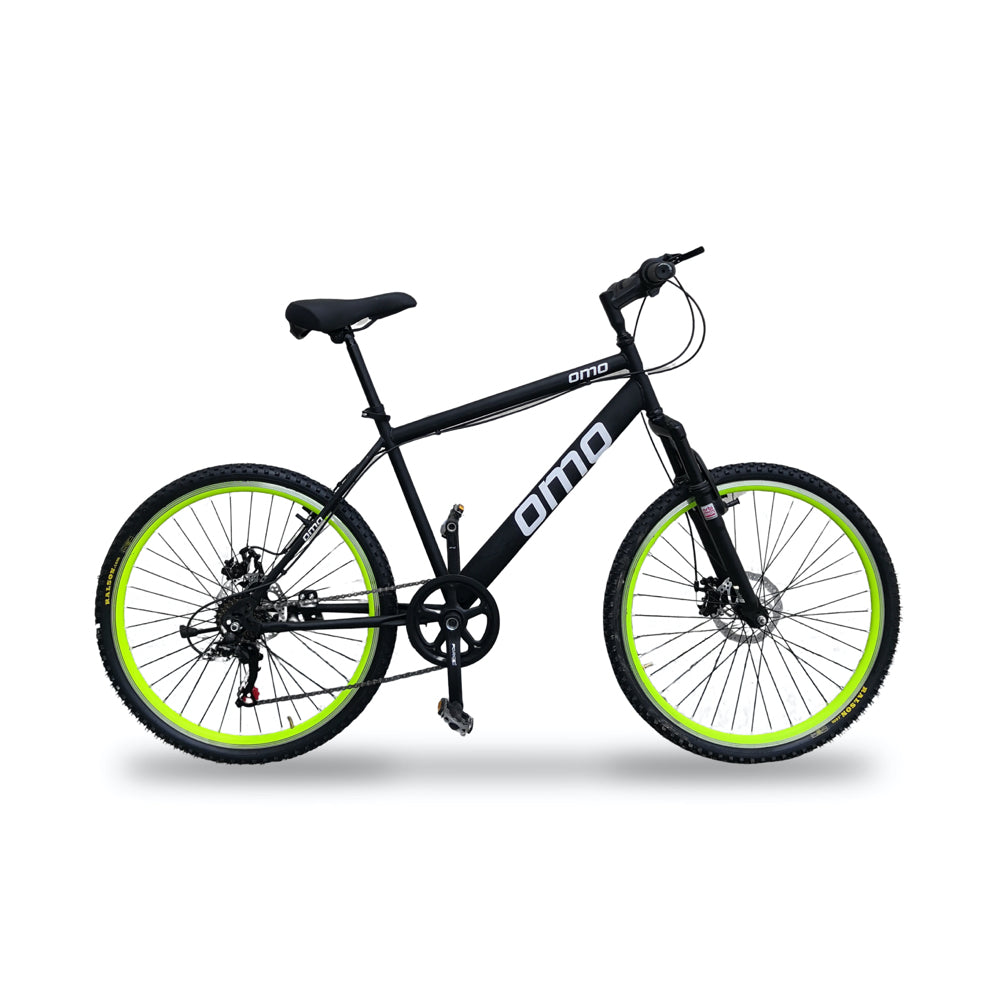How to Choose Perfect Mountain Bike / MTB for Beginners in 2025
Harsh KushwahaShare
A mountain bike is a multi-purpose bicycle used for city or off-roading purposes. Some people even use these bikes for stunt riding as well. Before we go further into the details of choosing the right configuration, let's discuss what a mountain bike is

What is a Mountain Bike or MTB?
Mountain bikes are a type of bicycle designed for off-roading, trail riding, or riding on rough terrain. Mountain Bike consists of front suspension or both front and rear suspension, with a wide range of gear to tackle to variety of terrain. They come in different styles, including cross country, trail, enduro, downhill, and fat bikes, each tailored to different types of terrain and riding preferences.
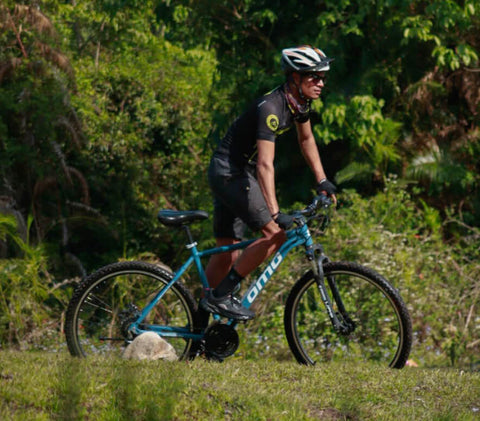
- Frame: Mountain bike frames are typically made of lightweight materials like aluminum carbon fiber or strong steel sometimes for a lower budget range, offering a good balance between strength and weight.
- Tire Size: Mountain bikes have wide tires, typically around 2.10 to 3 inches wide to provide good grip on rough trail roads or during off-roading
- Gears: Mountain bikes come with a wide range of gears, making them suitable for all time of terrains. Entry level mountain bikes have 7,8,9 , 21 or 24 gear while the professional riders use 1x10, 1x11 , 1x12, or 1x13 gear drivetrain
- Handlebars: Mountain bikes mostly have flat bars, as they offer smooth twisting and turning during trail rides.
- Suspension: Some mountain bikes feature only a front suspension fork to absorb bumps and shocks while other MTBs do have dual suspension which is used mostly by the adventure sports rider or professional MTB riders
- Versatility: Mountain bikes are versatile and can handle a range of activities including cross-country, trail, enduro, downhill, and fat bikes, each tailored to different types of terrain and riding preferences.

What are different Different Types of Mountain Bikes?
Different types of Mountain bikes are designed to excel in specific terrain and riding styles. Here are some of the most common types of mountain bikes:
- Cross-country (XC) Bikes: Cross-country bikes are designed for speed and efficiency on smooth trails. They have lightweight frames, narrow tires, and front suspension/hardtail bike or full/dual suspension. XC bikes are ideal for long endurance rides and racing.
- Trail Bikes: Trail bikes are suitable for both climbing and downhill riding, making them versatile options for a wide range of trails. They feature moderate suspension travel (80-120mm), and relaxed geometry, and are suitable for both uphill climbs and downhill descents.
- All-Mountain/Enduro Bikes: All-mountain or enduro bikes are built for aggressive trails and challenging climbs and downhill, while still maintaining efficiency on climbs. They feature longer suspension travel (100-170mm), slack geometry, and robust components to handle rough terrain and drops.
- Downhill Bikes: Downhill bikes are built for maximum speed and control on steep, technical descents. When you are going downhill, the speed of the bicycle is very high. These downhill bikes feature long travel suspension, and slack angles, and absorb impacts and maintain stability at high speeds. Downhill bikes are typically not suited for climbing due to their heavy weight and specialized design.
- Dirt Jump/Park Bikes: Dirt jump bikes are designed for jumping on dirt jumps, pump tracks, and bike parks. They have compact frames, rigid or minimal suspension, and durable components optimized for handling jumps, spins, and tricks.
- Fat Bikes: Fat bikes feature oversized tires (typically 3 -4 inches wide) mounted on wide rims, providing extra traction and flotation on soft surfaces such as snow, sand, and mud. They are specifically designed for riding on beaches and snow where regular bike tires don't have proper grips
- Electric Mountain Bikes (e-MTBs): Electric mountain bikes are battery-powered motor that assists the rider's peddling efforts, providing extra power for climbing and extending ride range.
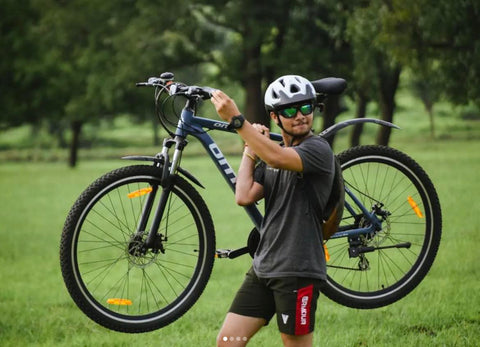
Which Mountain Bike or MTB is good for you?
Choosing the right mountain bike for you depends on various factors such as budget, daily usage, kind of terrain, and purpose of usage. Here's a step-by-step guide to help you select the right mountain cycle:
Determine your Budget
Decide how much you are willing to spend on a Mountain cycle. Prices can vary widely based on features and materials, so having a budget in mind will narrow down your options. It can vary from 10,000 to 50,000 in price range as well.
Correct Frame size and Wheel Size:
Choosing the right frame size and wheel is crucial for comfort and safety. To determine your frame size, measure your inseam (the distance from the ground to your crotch) and match it with the manufacturer's size chart. For a mountain bike, your inseam should be 1 inch to 4 inches more than the standover height of the bicycle frame in case on a Mountain bike. More clearance is suggested compared to a hybrid bike because of the more vertical movement of the bike during off-roading or adventure sports activities. 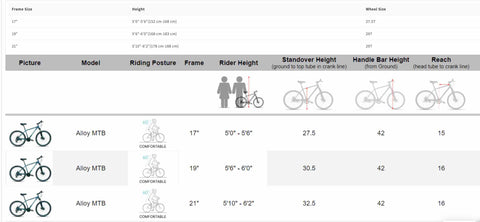
Determine your need (how many gears are needed in MTB).
Mountain bikes have thicker tires which provide more comfort and support on rough roads and better balance but on the other hand, it causes more effort to be used so gear preference for mountain bikes is different than other categories of bicycles
- For regular city commutes up to 5 to 10 km on flat roads 7 gear is suitable
- For 10-20 km of city commute on flat roads 21, 24 gear is suggested
- For Long rides like 40-50km on flat terrain 24, 29 Gear is suggested
- For hilly terrain 21, 24, and 27 gear is suggested
Check how to use Gear in a Mountain Bike on different terrains. TrickTrick
Which Brake to use based on usage in Mountain Bike?
If you are planning to use the MTB for city usage or small outdoor activities on flat roads or city roads, mechanical disc brakes are fine. However, if you are planning to use it for touring, long rides, off-roading, or mountain riding, hydraulic brakes are a must. Regular mechanical brakes also work for the mountain sometimes, but they are unable to provide the stopping power needed for downhill mountain riding. Only hydraulic brakes are most suitable.
Suspension in mountain bike
A bicycle suspension is decided based on rider weight as well as usage.
- 50 mm Steel Lockout: For rider weight below 100kg and city usage with speed breaker and small potholes, 50 mm Lockout preload is good
- 80 mm Zoom Lockout:- For rider weight below 115kg, zoom lockout with preload suspension can be used for mild off-roading and city rides as well.
- 100 mm Sr Suntour Lockout:- For rider weight below 145kg, Sr Suntour lockout with preload suspension can be used for heavy off-roading and city rides as well. The smooth spring suspension gives comfort on riding similar to a motorbike suspension
Brand & warranty
Research reputable bicycle brands are known for quality and customer service. Check if the bike comes with a warranty, and understand the terms and conditions. Brands like us Provide 90 90-day part Warranty from the day of delivery and a Lifetime warranty on the frame will help customers purchase online without much fear of part failure or any manufacturing defect.
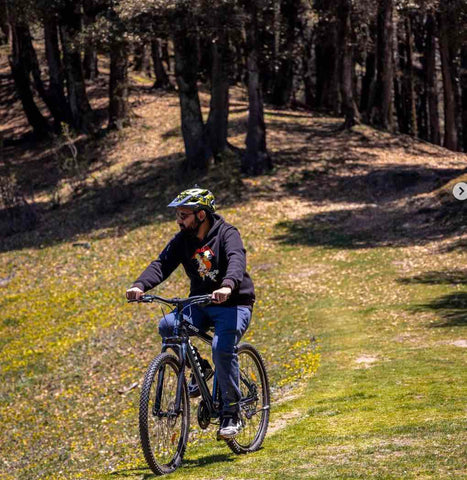
Should I Customise my Mountain Bicycle or MTB?
Having the right mountain bike can make all the difference in your experience on the trails or city rides as well. While there are countless options available on the market, sometimes the best bike for you isn't the pre-assembled bike. It's the one you customize to fit your unique needs and preferences or you build by yourself.
Frame Selection:
The foundation of any mountain bike customization is the frame. The frame determines the bike's geometry, which plays a significant role in how it handles different types of terrain. Consider factors such as material (aluminum, carbon fiber, steel), frame size, suspension type (hardtail vs. full-suspension), and geometry (slack vs. steep angles) based on your riding style and personal preferences. A perfect frame selection with other important components for your ride is possible through customization
Choose Components as per your style:
Choosing components like the suspension fork, drivetrain, or brakes can enhance your bike's efficiency, control, and overall ride quality. Choose components that match your riding style and budget, keeping in mind the balance between performance and durability, which is achievable through customization else you will end up compromising on one part or other.
Personalized Fit and Comfort:
A custom mountain bike isn't just about performance. It's also about comfort and fit. Adjustments such as saddle height, handlebar width, stem length, and suspension setup can significantly impact your riding comfort and efficiency. Investing in a customized bike fitting can help you minimize discomfort and maximize power transfer on the trails.
Aesthetics and Customisation:
Beyond performance and comfort, customization allows you to express your style and personality through your bike. From custom paint jobs and decals to colorful grips and accessories, the possibilities for personalization are endless. Build your bike and make your bike uniquely yours, turning heads on the trails while showcasing your passion for mountain biking.
Conclusion:
Finding the perfect mountain bike isn't always about choosing the most expensive or high-end model or the bicycle that your friend is riding. It's about creating a bike that's perfectly tailored to your needs, preferences, and riding style. Through careful customization and attention to detail, you can transform a stock bike into a personalized machine that enhances your performance, comfort, and enjoyment on the trails. So, saddle up, unleash your creativity, and embark on the journey of customizing your ultimate mountain biking experience.
